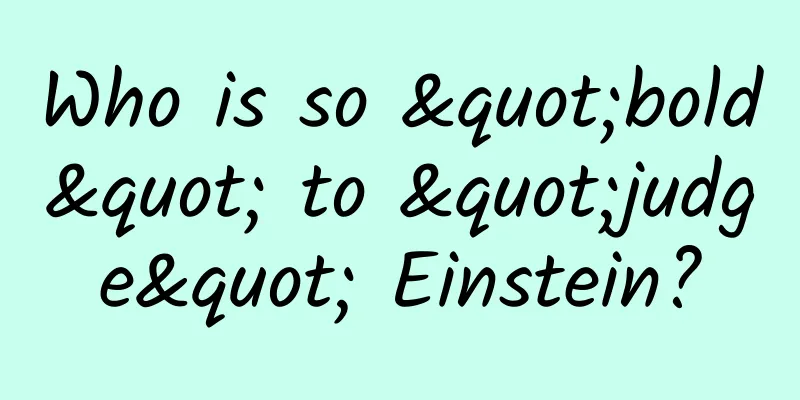Who is so "bold" to "judge" Einstein?

|
Not long ago, a new book by Canadian science historian Jeffrey Crelinsten, Einstein's Jury: The Race to Test Relativity, was published in Chinese. This book introduces the academic debate on this epoch-making scientific theory in the early days of the birth of special and general relativity, especially the fierce academic debate through repeated astronomical observations and physical experiments. These discussions not only include legitimate academic doubts and debates, as well as the misunderstandings of many experts in philosophy and physics, but are also accompanied by various anti-relativity attacks. There are not only misunderstandings caused by academic mistakes, but also malicious slander and attacks from those with poor academic ethics, academic frauds, anti-Semites and fascists, the intensity of which is shocking. Due to the fierce questioning of anti-relativists, the Nobel Prize Committee failed to list the theory of relativity, one of the most important and brilliant scientific achievements in human history, as one of the reasons for awarding Einstein the Nobel Prize in Physics. This "trial" of relativity, which took place in the 1920s and lasted for about ten years, was briefly mentioned in general scientific works, scientific history materials and popular science books without detailed description. Therefore, people who generally study, research and teach relativity do not have a deep impression of it. It was believed that with the support of first-class scholars such as Planck and Nernst, the special theory of relativity was quickly accepted by the academic community. It was believed that once the three major verifications of gravitational redshift, light deflection and Mercury's orbit perihelion precession were completed, the general theory of relativity was recognized by the academic community. It was impossible to imagine that after the birth of relativity, it would undergo such a harsh "academic trial". Of course, facts speak louder than words. The results of experimental observations and the gradual deepening of academic understanding eventually transformed those who participated in the "trial" of relativity into "witnesses" and supporters of relativity. In fact, similar situations also occurred during the spread of relativity in China. The author has been engaged in the research, teaching and popularization of general relativity for a long time. He has consulted many books and historical materials on relativity, including many biographies and comments about Einstein, but he has never seen such a detailed and wonderful introduction to this historical stage. It is really an eye-opener. The author of this book was able to complete such a book thanks to his solid and comprehensive academic foundation, and his active, diligent and pragmatic academic style. He has an academic background in physics, astronomy and history of science, and has collected information extensively from many scientific research institutions, schools and library and information institutions around the world, and has conducted in-depth exchanges with the parties involved and insiders, thus fully and correctly mastering a large amount of valuable historical materials. The translator of this book, Mr. Pan Tao, has been engaged in translating books about Einstein and the theory of relativity for a long time. He has published excellent translations such as "Einstein's Mistake". This time he has contributed the Chinese translation of his masterpiece "Einstein's Jury". I believe this book will be welcomed by readers. Reading this book will help readers fully understand the development process of the theory of relativity, and will also help young students understand the bumpy road of scientific research. ——Zhao Zheng (Professor of the Department of Physics at Beijing Normal University, former president of the Chinese Society of Gravitational and Relativistic Astrophysics) Written by Su Dao In the history of science about Einstein and relativity, 1919 is a year of special significance: in that year, an expedition led by British astronomer Arthur Eddington successfully observed a solar eclipse on Principe Island in West Africa, verifying the general theory of relativity's prediction that the light from stars would be deflected in the sun's gravitational field. From then on, Einstein and his general theory of relativity became "famous overnight." General relativity has completely changed the way humans have understood the universe for more than 300 years since Newton, giving completely different connotations to concepts we are familiar with, such as space and time. But when we face such a revolution in thought, in addition to being amazed at Einstein's creativity and insight, have we ever wondered why the heliocentric theory proposed by Copernicus was finally recognized after the unremitting promotion and dissemination of Kepler, Galileo and others, while Einstein's theory was even more difficult to understand and beyond our daily experience, so how could it be completely accepted by just one observation led by Eddington? In fact, the situation is completely opposite to what we often read in textbooks or popular science books. In the period before and after the solar eclipse observation in 1919, the scientific community paid great attention to Einstein and the general theory of relativity. Among them, doubts and oppositions were heard constantly, and even became the mainstream for a period of time. The general theory of relativity has three important predictions, which are actually all astronomical predictions: the new value of the precession of Mercury's perihelion, gravitational redshift, and the deflection of light in the gravitational field. Therefore, whether you want to confirm or falsify the general theory of relativity, you can't do without the work of astronomers. These astronomers are the protagonists of the book "Einstein's Jury: The Race to Test Relativity" by Canadian science historian Jeffrey Crelinsten, and the extensive research and observations they conducted to verify these predictions and the ensuing debates between 1910 and 1925 constitute the main content of this book. Crelinsten brought up the "jury" that only appears in court in the title of the book to remind us how fierce the confrontation between them was; and this book can be described as a detailed "scientific court record", recording many details that are crucial to evaluating this competition. Since the mid-19th century, as a series of physical methods were introduced into astronomical research, astronomy gradually changed its previous research model based on astronomical measurement and orbital calculation, and deeply integrated with physics, thus giving birth to astrophysics. After entering the 20th century, physics became the mainstay of astronomical research. If the several important papers published by Einstein in 1905, the "miracle year of physics", were still discussing physical problems, then the general theory of relativity, a brand-new theory that describes the structure of the universe and space-time, inevitably entered the field of astronomy and had the potential to completely reshape this field, which naturally attracted the attention of astronomers. "Eddington used solar eclipse observations to verify the theory of general relativity" is only an extremely simplified and misleading version of this history, but Einstein's Jury fully restores this history, which is the important value of this book. The astronomers introduced in the book are not only numerous, but also have different views, showing a scientific community with complex relationships. However, the German astronomer Erwin Freundlich, who Krellingsten wrote about a lot in the book, was a "little guy". Among the followers of general relativity, he did not have the same status as Kepler and Galileo in the heliocentric theory, and it was difficult to find his name in the credit book, but the irony of history was vividly reflected in him. Although he did not receive support at his workplace, the Royal Observatory in Berlin, and was suppressed by the director, he still made every effort to carry out relevant research and observations, hoping to provide strong support for this new theory. The equivalence principle proposed by Einstein in 1907 was the prototype of the general theory of relativity. Based on this principle, he calculated that the deflection angle of starlight passing by the sun was 0.87 arc seconds. After establishing the complete general theory of relativity in 1915, he recalculated and revised this angle to 1.74 arc seconds, which is twice the previous value. The actual size of this deflection angle can only be measured when a total solar eclipse occurs, so astronomers need to wait for the right time. In 1914, Freundlich finally got the chance and led an observation team to the Crimean Peninsula in Russia to observe a total solar eclipse. However, at this time, the First World War broke out and Germany and Russia were at war, so the observation team was arrested (later released and returned to Germany) and failed to carry out the planned observations. Imagine if the observation team led by Freundlich had not encountered any accidents, but had successfully completed the observations as planned in clear weather, and the data quality was satisfactory, then the results obtained from this observation would have overturned the values predicted by Einstein in 1907. In other words, the blow suffered by the ambitious Freundlich actually "saved" the general theory of relativity and gave Einstein time to perfect the theory. Unfortunately, he also left the opportunity to go down in history to Eddington. In this period of history, Eddington is an indispensable central figure. One of his stories is widely circulated: a reporter told him that he heard that there were only three people in the world who truly understood general relativity. He paused and then said that he was wondering who the third person was. Regardless of whether it was just a joke or he was really so confident, what he said was not true. In this period of history restored by Krellingsten, Eddington's image also became three-dimensional. In fact, when he led the famous observation and announced the victory of general relativity to the world, Eddington did not really understand the theory. He gradually improved his understanding in the following years. More importantly, when Eddington processed the observation data, he consciously selected those data that supported Einstein's predictions and ignored other data. This was obviously not in line with the norms of scientific research and was criticized by many astronomers at the time. The total solar eclipse observation in 1919 helped general relativity enter the public eye, but the result did not convince the astronomical community, and there was a story that astronomers continued to organize total solar eclipse observations many times to test general relativity. In the early 20th century, the "four major countries" of physicists also had the most astronomers, with the United States and Germany having the most, followed by France and the United Kingdom. Therefore, the astronomers participating in the competition to verify the general theory of relativity also mainly came from these four countries, and they also formed two camps, Europe and the United States, with the Atlantic Ocean as the boundary. If we withdraw from the observational data and mathematical analysis carefully listed in Krellingsten's book, and start from Freundlich and Eddington, two representatives of the German and British astronomical circles, to explore the status and changes of astronomy and even the entire science in the context of the grand era, we may gain more insights. The period of time this book focuses on is not only an era of revolutionary changes in physics (and astronomy) (in addition to general relativity, quantum mechanics also ushered in a boom during this period), but also an era of turbulent international situation. The First World War had a profound impact on Europe, which was the center of science at that time, and science would naturally be in this turmoil. A competition to verify the general theory of relativity not only took place within the astronomical community, but also involved reconciliation and confrontation between countries. This tone accompanies the narrative of the entire book. A British observation team verified a theory proposed by a German shortly after the end of the First World War, which was considered a sign of peace returning to Europe and even rationality triumphing over barbarism. But at the same time, when reporting on it, The Times called Einstein a "Swiss Jew" and avoided the fact that he was conducting research in Germany; and when the German scientific community sought funds to carry out related research, an important reason was "to have Germans verify German theories", and Freundlich raised funds to build the "Einstein Tower" for astrophysics research. We often say that "science has no borders, but scientists have a motherland." This history provides us with good material for discussing whether science and scientists can transcend politics and national boundaries. In the first half of the 20th century, the world's scientific center shifted from Germany to the United States. One of the landmark events was Einstein's move from Germany to the United States and joining the Institute for Advanced Study at Princeton. At the same time, a group of outstanding physicists crossed the Atlantic from Europe to the United States. In this book, we can see that since the beginning of the 20th century, with the take-off of the US economy, the government and private sector have increased their funding for scientific research, and signs of this "shift" have already appeared in the field of astronomy. On the one hand, astronomical research has high requirements for observatories and telescopes. At this time, the United States vigorously built observatories and soon caught up with and surpassed Europe, thus having the material basis for the development of astronomy. On the other hand, American astronomers represented by George Ellery Hale realized that the American astronomical community was lacking in theory, and actively recruited well-known European scholars to join with superior observation conditions. Under this general trend of "transfer", the American astronomical community gradually got rid of its image as a nouveau riche and began to play a pivotal role in the world astronomical community. Therefore, American astronomers did not stay out of this competition. They first learned about the research trends on the other side of the Atlantic Ocean, and then joined in. In addition to the competition within Europe, there was also a competition in the astronomical community on both sides of the Atlantic Ocean. American astronomers joined the "jury" this time, and many observatories became research centers, which was a good start for leading the world's astronomical research in the next century. The "jury" composed of astronomers decided the fate of general relativity in the court of science, but the most glorious achievement of human rationality did not receive unanimous support at the beginning. It was only in the constant confrontation that the truth became clearer and clearer, and the "trial" result was finally recognized by the scientific community. In fact, all readers of "Einstein's Jury" also constitute a special "jury" - our identities are more diverse and more in line with the requirements for jury members. Although we may not be able to test the authenticity of general relativity, we can use a wonderful "scientific court transcript" to make our own judgments on issues such as the nature of science, the development of science, and the relationship between science and society. This article is supported by the Science Popularization China Starry Sky Project Produced by: China Association for Science and Technology Department of Science Popularization Producer: China Science and Technology Press Co., Ltd., Beijing Zhongke Xinghe Culture Media Co., Ltd. Special Tips 1. Go to the "Featured Column" at the bottom of the menu of the "Fanpu" WeChat public account to read a series of popular science articles on different topics. 2. Fanpu provides a function to search articles by month. Follow the official account and reply with the four-digit year + month, such as "1903", to get the article index for March 2019, and so on. Copyright statement: Personal forwarding is welcome. Any form of media or organization is not allowed to reprint or excerpt without authorization. For reprint authorization, please contact the backstage of the "Fanpu" WeChat public account. |
>>: How far does Greater Beijing have to go to become a “zero-waste city”?
Recommend
Evolution of IoT technology: wireless connection + smart sensors
The Internet of Things is a term for connected em...
Roewe RX3 Guangzhou Auto Show real shot: the most suitable compact SUV for young people is this
The Roewe RX3, which was released before the Guan...
China's Denza to the world's Denza! Denza's overseas expansion to accelerate in 2023
As a luxury new energy brand jointly created by B...
[Fat Bear Science] Take you to count the carcinogens hidden around you in life
Fat Bear: Grandma, haven't you finished the n...
Yan Ning's students talk about: What should I do if I want to give up my doctoral studies? What path should I choose after graduation?
The Women in Science Forum is now in its seventh ...
How much money does GuangDianTong spend in a day? How much does one GuangDianTong advertisement cost?
With the advent of the 5G era, mobile Internet is...
Should drowning first aid be treated by "hanging upside down to control water"? Drinking more water will help you recover from a cold faster? Here comes the list of scientific rumors for May →
1. E-cigarettes are healthy and harmless. Rumor c...
How to unleash the power of Moments advertising?
Since joining Tencent Wealth Management a year ag...
Who is healthier, a person who keeps urinating after drinking water or a person who doesn't go to the toilet for half a day?
This article was reviewed by Zhu Hongjian, Chief ...
Introduction to GIT - Basic Concepts and Operations
[[141900]] First of all, it must be pointed out t...
Mysterious oriental power! Fermented tofu becomes "Chinese cheese", how attractive is it?
As one of the oldest processed foods, cheese has ...
Basic steps to build a website: What are the 7 basic processes of website construction?
In the era of Internet marketing, both traditiona...
With the implementation of the new paid advertising policy, the ASO market has undergone tremendous changes!
A few days ago, Apple confirmed that it would eva...
Apple server abnormalities have caused a sharp drop in the daily activation volume of many apps!
In the past two days, many friends have reported ...
The "Pink Static Electricity" True Love Challenge is a Hit! Is there any scientific basis behind it?
Review expert: Zhou Hongzhi, senior laboratory te...









